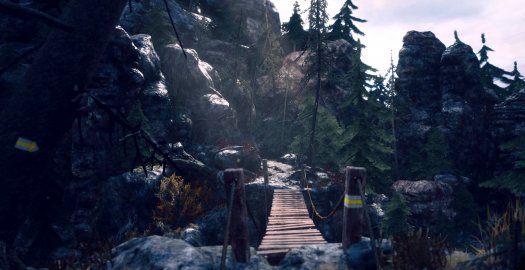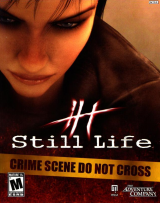Review for Someday You’ll Return

Ordinarily if you asked me about designing a game, one key bit of advice I’d offer would be to never give players a reason to quit playing because they may not resume again. CBE’s first-person horror adventure Someday You’ll Return is different. I actually measure its success by the number of times I felt that I had to step away, if only to take a break from the awesomely tense atmosphere it carries through much of its lengthy running time. Set in the contemporary Moravian woods in the Czech Republic, this is no simple stroll among sun-dappled trees. Both psychological horrors and jump-out-and-go-boo scares await within this tale of one man’s search for his missing daughter and the confrontation of a buried past that he would just as soon forget. It’s just too bad – or perhaps fitting? – that he’s not a nicer guy.
Early on, very little is revealed about Daniel, the protagonist, save that he’s driving to the forest in search of his daughter Stela, who’s run away from the home of Daniel’s ex-wife. Daniel shows no concern over the young girl’s predicament, only a simmering anger that always lies just below the surface. In short order he curses his cheap cell phone, his car and his shoes, and those are just the inanimate objects that infuriate him. Much of his vocabulary can be found in the dictionary under “F” and rhyming with duck. He routinely shouts and swears at other characters he meets, to the point where I started to feel a bit embarrassed for the guy. Making a lead character so unpleasant is certainly a bold design choice and naturally raises the question of why this man is so angry. But there is little time to ponder Daniel’s past right away, as there are more pressing matters at hand: he had previously arranged to have spyware installed in Stela’s phone that he could then track with his own.
Naturally, things don’t go as well or as quickly as Daniel expects. Cell phone reception is spotty and after a nasty tumble, he loses his phone entirely. Worse yet, as Daniel continues his hunt, he comes across an old tunnel/bunker system. Underground, gone are the gorgeous views of nature’s tall trees, rounded boulders, and running brooks, replaced instead with rusted metal doors, concrete slabs, and bits of iron rebar bent in gnarled shapes. Daniel revisits different sections of these poorly lit forgotten passages frequently throughout the game, illuminating them with his cell phone (while he still has it), a flashlight, and occasionally wall-mounted torches. Such meagre light sources usually only serve to reinforce how dark and claustrophobic these subterranean areas are as the light doesn’t penetrate far into the shadows. Corridors are narrow, ceilings are low, and there’s a beast wandering around down here.
The beast. Daniel initially believes it to be some homeless person just trying to scare people away from the tunnels in which it resides, despite its fearsome look reminiscent of a Predator if it was covered in wicker armor. Job well done when the beast corners Daniel early on and kills him. Or maybe it doesn’t, because Daniel regains consciousness in some twisted nightmare perversion of a forest. Black tar-like water surrounds him, gnarled trees jut up like toothpicks, and a girl dressed all in white greets him. Daniel claims that all he wants to do is find Stela, and as is his wont, he gets angry at the girl when she proves less than cooperative. Even so, it becomes clear that the protagonist is haunted by demons buried in a realm beyond merely the physical one. If he’s to find his daughter, he will have to brave his past to discover the truth about himself as well.
The story takes place across at least several days and nights. The actual passage of in-game time is difficult to gauge because when Daniel alternates between above and below ground, time gets messed up for him. At one point he loses track of a couple of days, at least according to the messages accumulated on his cell phone. This temporal anomaly is among the many mysteries that are never definitively answered, which is one of Someday You’ll Return’s greatest strengths. The game is long, taking me nineteen hours to complete its twelve chapters and reach one of the five endings available based on the discoveries made along the way. Through all of that, many questions are raised about Daniel, his connection to the forest, his relationships with Stela and his ex-wife, the nature of the beast, and so on, but few actual answers are provided. Only subtle hints and clues are given as to what may be going on, but there’s just enough of these wisps of information to allow players to speculate and decide for themselves what it’s all about. Even so, I would have preferred at least a few concrete resolutions to some of the more burning questions.
Daniel’s journey is mostly solitary but a few other characters do pop up. There’s the girl in white, of course, who seems able to read Daniel’s mind and sits in judgement over him. Then there’s an old woman who knows more than she’s letting on and clearly thinks little of Daniel. The only sort of friend Daniel finds is Eleanora, a woman visiting the forest alone who offers her help in the search for Stela. As the two explore, separately from one another, it’s evident that Eleanora is doing a bit of detective work on her own and that she too is withholding information. Then there’s another young girl named Lea, who may or may not be able to help Daniel with his quest but only if he recovers her lost doll from the lair of the beast. Each of these characters and Daniel are fully voiced with no poor performances. If anything, they’re almost too convincing as the arguments Daniel gets into with the other characters can start to get a little uncomfortable with the voices becoming quite heated.
The nagging suspicion of those you meet coupled with the persistent lurking threat of the beast would be enough to set one’s teeth on edge with the tension, but Someday You’ll Return goes beyond that. Dark forces are at work in the forest, and Daniel repeatedly finds shadows creeping in around the edges of reality. At various points, usually at night, foglets – dark, shambling, zombie-like creatures – come out and wander around looking for any tasty explorer who happens by. Upon spotting such a prey, they reveal their true faces, transforming into grotesque spidery creatures that scream chillingly and charge ferociously. There is no defense against them; all that can be done is to stick to the shadows and stealthily creep past them through a landscape that becomes increasingly riven with cracks, pits of fire, and smashed chunks of concrete as the darkness Daniel faces becomes more pronounced.
Sneaking quietly is harder than it should be as there is no way to lean out from behind cover to see if anything is coming. You have no choice but to listen closely for anything that may be approaching and hope for the best. On the plus side, thanks to an update implemented after the game’s initial launch, the amount of stealth can be greatly diminished by brewing a “Devil’s Pact” potion from various scattered plants and herbs. While under the effects of this spell, most creatures that would do Daniel harm will not detect him unless he’s basically standing right in front of them. That still doesn’t diminish the edge-of-your-seat tension that comes from skulking through darkened landscapes, lit only by flickering lamps or fires, with the scuttling sounds of nether creatures wandering all around you, though.
The handling of suspense can make or break a horror game. Fortunately, this one deals with it admirably. Events vacillate between safe exploratory sections, threatening stealth sequences, and out-and-out dangerous chases. Interspersing the more obviously lethal sections with the opportunity to leisurely roam around provides players with a welcome release from tension, but not too much of one. The forest, for example, is sufficiently dense that something could be lurking around the next corner. This was never meant to be a comfortable experience, and indeed I found my nerves couldn’t take playing for more than an hour before I needed a break. And yet there was always something compelling to make me want to keep coming back, keep moving forward, whether it was the discovery of a new location, a new trail to follow, or spotting one of the few human characters in the distance.
For me the tensest sequence occurred in a place where the greatest danger was the one I only imagined. I won’t spoil the exact location, but suffice it to say I ventured somewhere that I had good reason to expect an encounter with the beast. Everything about the area was eerie, from the oppressive walls, to the macabre decorations, to the distant beating of a giant demon heart, growing louder as I crept through. Daniel even said something to the effect that things couldn’t possibly get any worse. As anyone who’s seen any kind of horror movie should know, that’s basically the kiss of death. I was more freaked out by the mere apprehension of its appearance than the threat that it actually posed.
The stealth potion isn’t the only time you’ll encounter the game’s intricate herbalism component. Growing in various groves and bushes are an assortment of ingredients for constructing a variety of medicinal brews. Most, like the Devil’s Pact, only have a limited-time duration before needing to be made again. Others, such as one for detecting where spell components are, are more permanent. Early on Daniel receives a couple of recipes and a compartmentalized wooden box for storing ingredients. Flowers can be chopped up for their individual leaves, petals, and roots to be added to a boiling pot that Daniel also finds. Sometimes these ingredients must first be ground with a mortar and pestle before being used.
Making a mistake and getting a concoction wrong requires it to be thrown out before starting again from the beginning. However, I never encountered any issues with running out of ingredients as the plants I picked would respawn again after leaving them for a short while. Aside from the practical matters of finding more ingredients and avoiding the dark creatures, other potions allow the protagonist to reveal hidden text in documents, or clearly hear conversations of the past whenever the forest starts whispering to Daniel or blowing up little clouds of dust. Yet another brew gives Daniel the ability to focus through vertigo-inducing swirls in the air that can cause him to fall to his death from bridges or narrow causeways. If you get caught off guard, rest assured that death here simply results in the game being immediately reloaded before the fatal steps are taken.
Someday You’ll Return also features many more traditional puzzles, including inventory challenges with a bit of a crafting twist. Accessing the inventory causes a window to pop up covering the entire screen. Collected items are 3D objects that can be rotated, which is necessary sometimes to find important hotspots on them, such as covers or panels on things that can be opened. Items that can be combined receive a special icon, and when selected will display a small circular meter that progresses based on how many objects in total have been combined. For example, if a given object needs four other pieces added to it, the meter advances by a quarter for each component placed until the entire construction is complete.
Outside of the inventory screen, glowing white stars appear in the game world when drawing close to objects that can be interacted with. In some cases this is a direct action, such as opening a door, while in other cases an item is needed to progress. If the object is already in your inventory, an icon for it appears automatically on the hotspot; if not, a question mark shows instead. Movement through the 3D environment uses a standard keyboard/mouse combination or a game controller and works well enough both ways, though a gamepad fares worse when navigating menus, the inventory and journal. Certain keys or buttons allow for running (although sadly there is no toggle option) and crouching (useful for getting through tight spots or being stealthy). In some places, movement becomes a bit precarious. When crossing a narrow beam, for example, Daniel will wobble from side to side, demanding minor course corrections to keep him going straight ahead.
Occasionally vertical movement is also possible on walls that have bricks or stones protruding from them which can be used as handholds to climb to higher levels. Daniel grabs the first handhold with one arm, and his other arm must be positioned over the next spot he can grip before hitting a button to grab it and release the previous handhold. Scaling walls this way is not as simple as, say, climbing a ladder, and sometimes very specific courses must be charted through the handholds to reach your destination. I really enjoyed these climbing sections, although I always felt a bit tense upon reaching the top because I was convinced that some kind of face-ripping monster would be waiting.
I enjoyed just wandering through the open forest areas, too. Like many public nature paths, the ones through the Moravian woods have assorted coloured trail markers as well as more natural landmarks like rivers and odd stone formations. A number of times you’ll find letters, journal entries, or pages of directions from a campsite that describe paths through the forest based on these assorted breadcrumbs. The developers also incorporated subtle visual and audio cues to help guide players about. Flickering lights, for example, are often used in dark locations where visibility is otherwise poor to act as guiding beacons to the next key location. The orienteering aspect is both intuitive and quite fun, really making me feel like I was free to explore on my own rather than being funneled down one particular path, yet without much risk of getting lost.
Fortunately, the game proves canny in knowing exactly when to do a bit of overt funneling. With the dark forces seeking to do Daniel harm, it’s inevitable that he gets chased by them. During these sequences, the open areas of the forest give way to narrow paths that may be strewn with obstacles but are otherwise linear. Escaping therefore becomes a matter of running along these paths, dodging the stationary hurdles in order to reach safety.
My particular experience with the chase sequences wasn’t as fun as it could have been because my eight-year-old graphics card wasn’t quite up to the demands. Even with everything turned down to the lowest setting, I would get frequent stutters while moving fast, especially when turning. Interestingly, despite having four detail settings (low, medium, high, and ultra) I couldn’t see much difference between the bottom three. On my computer, each reduced the level of detail to the point where informational park signs became illegible and the textures of boulders and trees became so blurry as to resemble melted ice cream more than bark or gritty rock. Stepping up to ultra makes the game look markedly better but caused even more stuttering for me. Someday You’ll Return is based on the Unreal 4 engine and I’ve run other games perfectly fine using that engine, so I must assume that some optimizations are lacking here.
Even with the visuals reduced, I still found a number of locations quite impressive. I stopped just to take a look around at one point when I reached a natural underground grotto in Karst Caves. My reaction was literally, “Whoa, this is cool.” Damp stalagmites and stalactites abounded in a large cavernous space with an underground river burbling nearby. Elsewhere a mist-shrouded castle also caught my attention, like something out of a fairy tale – one of the dark ones. And a large cylindrical tunnel with a bright light at the end and passages from Stela’s journal burned into its sides displayed a serene elegance. Besides the lush forest and underground bunker system, you’ll also visit an old campsite that the protagonist used to run, an isolated cabin discovered at night that you’ll be convinced the beast is going to invade when Daniel tries to sleep, and all the surreal areas of the dark reality creeping in with their industrial remains and assorted bits of detritus from Daniel’s own life juxtaposed against one another.
Sound can play a key aspect in ratcheting up tension and providing scares, and Someday You’ll Return uses its audio very effectively. Rarely is there any musical accompaniment; instead the relative quiet of ambient sounds takes precedence. In some cases the sound drops out almost entirely, leaving only the faint tread of Daniel’s feet on the ground. Such moments feel like what they are: the calm before the storm of the next good scare. Then there’s the beast itself, which has its own distinctive effects. When you hear it lumbering closer, you know it’s time to run and hide! The other scary creatures have frightening snuffles, shuffles, and screeches to increase the general anxiety as well. Occasionally music does filter in with a few songs with vocals. These pieces are pleasant enough, ranging from folk to soft rock, but I always found their insertion a bit odd, as the tracks are so few and far between that I would mistake them for part of the organic soundscape, like something playing on a radio. Even so, they are so rarely used that they never distracted for very long.
In such a long game it can be hard to keep track of what events have happened and what needs to be done next. Fortunately a journal is provided that not only outlines the main goals that need to be accomplished in a non-spoilery way, it also stores the many notes, documents, and pages of fairy tales acquired in your travels. The journal also has a summary page that monitors the number of collectibles discovered. Candy wrappers litter the forest and can be picked up, camp merit badges can be found, pages of sheet music can be located, and so on. There are a tremendous number of them all told, and I didn’t come close to finding them all despite doing what I thought was a good job of searching thoroughly. There is a lot of ground to cover!
Recording progress is a bit strangely implemented. Most games either go with the limited single autosave or else provide a fully functioning save anywhere system. Someday You’ll Return falls between those two. It doesn’t allow manual saves, but when an autosave checkpoint is encountered a new save file is created, all of which can be accessed from the main menu. It’s a better system than just a single save, but with no real identifying information other than the chapter and timestamp of when the save was recorded, you may have to resort to testing multiple saves to find the one you want to load if you intend to go back to an earlier point to perform different actions in search of alternate endings.
Someday You’ll Return does an effective job of being a frightening horror adventure. Most of the thrills are of the jump scare variety but there are a fair number of moments that are truly creepy in between. With its unpleasant protagonist and only hints as to what everything means, it’s a more challenging story than those found in the vast majority of games. Subtle guideposts, climbing, potion brewing, documents to read, collectibles to locate, monsters to avoid – there’s a wide variety of things to do here, fitting for a game of this length. And a vast array of locations makes this so much more than just a walk in the park. Its tense atmosphere, occasional stealth sequences, mature subject matter, and an antihero in the forefront mean this isn’t a game that will appeal to everyone. But what it does, it does extremely well, and those who aren’t afraid to get their heart pumping with a good fright every now and then will find an experience that is both disturbing and compelling, grotesque and beautiful, in (mostly) all the right ways.
































